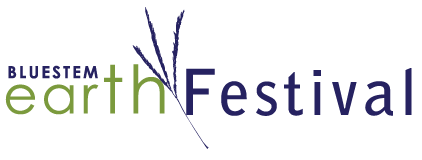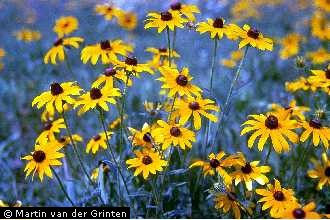
Black Eyed Susan – Yellow Flowers with black center on top of a green stalks.
Yellow Jessamine is not good for bee but especially is not good for humans as all parts of the flower are poisonous. Why wouldn’t you use a Black-Eyed Susan instead? Bees love it. We love it. Everybody wins. Oh, and Yellow Jessamine is not native to Illinois. It won’t live past a winter here until the climate changes.
Image description: Yellow Flowers with black center on top of a green stalks.
Rhododendrons; Beautiful for thee, not so good for bee.
The honey bee will tend to stay away from this flower unless there is no other source of nectar nearby. Honey that has been made with mostly Rhododendron pollen/nectar if eaten by a human has been known to cause intoxication, but only the associated yucky part. Not the lucy goosey fun part.
Instead of a pink Rhododendron choose a pink Clematis. It’s friendly to bee and thee.
We don’t have an image. Clematis is a vine with large flowers. You can get one of almost any color.
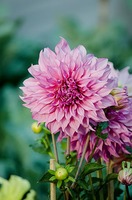
Dahlia – Large single pink flower whose petals twirl to the center.
Keep your Amarylis inside and plant Dahlias outside. Dahlias are bee friendly. The Black Dahlia is a horrible unsolved murder mystery best left for ghost stories.
Image description: Large single pink flower whose petals twirl to the center.
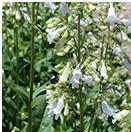
Foxglove – White trumpet shaped flowers drooping downward. Many trumpets on a single green stalk.
Choose the bee and hummingbird friendly Foxglove instead of the bee unfriendly Azealea. Don’t choose Foxglove if you have small children or pets who might want to nibble on the plant. The flowers are inviting and just about the right size for a finger to be stuck in it, or for a fox to slip his feet into to soften his step as he sneaks into the chicken coop. Foxglove is used to make the medication digitalis (digitalis = “measuring a finger’s breadth”). All parts of this plant are poisonous to mammals, that includes you human.
Image description: White trumpet shaped flowers drooping downward. Many trumpets on a single green stalk.
Who would have known? The Star Gazer Lily is bad for your cat. Anything that is bad for a cat can’t be good for a bee. We like cats so plant Hollyhocks instead of the Star Gazer Lily.
No image. Hollyhocks are large flowers on tall stalks. One can find several color of hollyhock and I think I saw one that was multi-color, but I might have eaten some of that Rhododendron honey then.
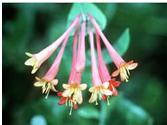
Trumpet Flower – Multiple slender pink trumpet shaped flowers arising from a center flat green leaf.
The ornamental Trumpet flower, also known as Angel’s Trumpet, (Brugmansia) is not an angel to bee or a human unfortunate enough to ingest the poisonous sap, but it sure smells sweet. In the bee world it can kill itty bitty bee babies while in their chamber. Since Angel Trumpet can survive only in containers (brought inside over winter) it would be better to grow sweet smelling trumpet honeysuckle instead (Lonicera sempervirens and related spp.) You get the nice smell with no risk to human or bee. Make sure you get a native honeysuckle and not the invasive type from Korea, China or Japan. With native honeysuckle you’ll attract not only bees but hummingbird too.
Image description: Multiple slender pink trumpet shaped flowers arising from a center flat green leaf.
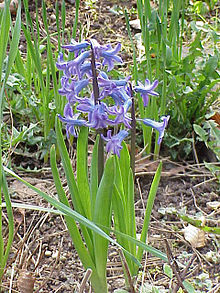
Hyacinth – Mid-height purple/bluish flower petals starting about half-way up a stalk with multiple long, slender green leaves surrounding the center stalk stopping about half-way.
Heliconia or Lobster-Claw is an intriguing plant but for the honeybee it’s bad for the brood. The good news for us it that Heliconia is generally not found in Northern Illinois. Hyacinth is the Nature-all choice. Hyacinth is especially favored by beekeepers because oxalic acid comes from it. Oxalic acid is the organic choice to kill the Varoa mite, an invasive insect that snuck in on stuff shipped to the U.S. in the 80s. The Varoa mite is one of the reasons why honeybee health is so critical, especially since your beehive’s health affects my beehive’s health even though we live miles apart.
Image description: Mid-height purple/bluish flower petals starting about half-way up a stalk with multiple long, slender green leaves surrounding the center stalk stopping about half-way.
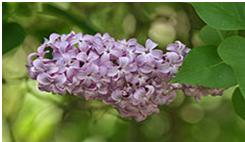
Lilac – Similar to hyacinth in shape but more purple/pink and the flower petals start at the end of a limb on a bush.
Mountain Laurel nectar makes for bitter honey. Don’t plant it if your goal is “bee friendly” even though it is a native. Plant Lilacs instead even though it’s not native. You’ll get the same color flower but in addition you get the lilacs’ sweet fragrance, and the entertainment of watching bees and butterflies dance from flower to flower. You won’t see that on a Mountain Laurel unless there is nothing else available. Lilac has been naturalized here so it’s okay to plant it in good conscience.
Image description: Similar to hyacinth in shape but more purple/pink and the flower petals start at the end of a limb on a bush.
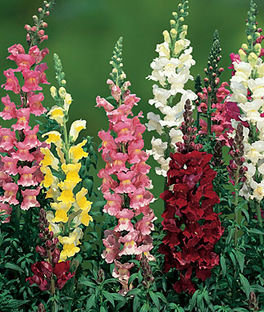
Snapdragon – Mid-height multiple stalks with flower petals starting at the bottom of the stalk. Each flower is a different color; Yellow, white, pink, maroon. The snap dragon gets its name from the snap that is made when the “dragon’s mouth” is squeezed.
Oleander is a bee hive killer, is poisonous to human, and poisonous to the bird that eats the oleander caterpillar. The threat to bee is small unless it is the only pollen that’s available. Snapdragon would be a better plant for us because, well it’s bee friendly and will live through a Northern Illinois winter.
Image description: Mid-height multiple stalks with flower petals starting at the bottom of the stalk. Each flower is a different color; Yellow, white, pink, maroon. The snap dragon gets its name from the snap that is made when the “dragon’s mouth” is squeezed.
Other native plants good for bees, butterflies, and hummingbirds:
- Bee balm (Monarda spp.)
- Butterfly bush (Buddleia alternifolia)
- Butterfly weed and other milkweeds (Asclepias spp.)
- Cardinal flower (Lobelia cardinalis)
- Clover and other legumes
- Columbine (Aquilegia spp.)
- Coneflower (Echinacea spp.)
- Delphinium (Delphinium spp.)
- Fuchsia (Fuchsia spp.)
- Honeysuckle (Lonicera spp.)
- Jewel weed (Impatiens capensis or pallida)
- Lobelia (Lobelia spp.)
- Lupine (Lupinus spp.)
- Penstemon (Penstemon spp.)
- Phlox (Phlox spp.)
- Salvia (Salvia spp.)
- Trumpet creeper or vine (Campis radicans)
- Weigela (Weigela spp.)
- Zinnia (Zinnia spp.)
Here’s the deal about going “All Nature-All”. If you plant natives they will grow and you don’t have to do much extra work. They grow well. They grow very well. They grow extremely well because, well they are at home. If you willy nilly plant you may find yourself in a little trouble because some grow very tall with very deep roots. Plan well. There are folks who are experts at landscaping with natives who will be glad to help you out FOR FREE! Check out the resource list.
Sources:
Eve Betts Countryfile Magazine “Top 10 Plants that are Bad for Bees.”
Wikipedia. Bees and toxic chemicals. Click to an interesting Wiki.
Illinois Extension “Bee Friendly in your Garden” Sandra Mason.
USDA Natural Resources Conservation “Wildlife Habitat”
And the ever resourceful search engine du jour, Duck Duck Go with the no tracking option.
Resources:
Illinois Extension Master Gardeners
Will County Wild Ones
Will County Beekeepers Association
Natural Resources Conservation
Images Source:
USDA: Natural Resources Conservation Service
Black-Eyed Susan
Foxglove
Honeysuckle
Burpee Seed (Non-GMO status)
Snapdragon
Wikipedia
Dahlia
Hyacinth
Lilac

